I’ve been drawing ever since I was 3 years old.
But most of it was garbage because I just drew for fun.
My childhood entailed a lot of paper-mache projects, coloring books, and random sketches (some of them unfinished).
I loved drawing.
But I didn’t ever think I could grow up and make a career from my art.
But I am a full-time Artist and Blogger now. And in this post, I will show you how to become a full-time artist without a degree.
So, if you too love to draw and are wondering if it’s possible to become a full-time artist, I’m here to tell you that it is!
This post is really heavy because I have covered a lot of information. So, feel free to bookmark this post and return to it from time to time so that you can go on to become a full-time artist!
I will also provide you with resources to help you understand how to make money as an artist and pursue your career as an artist.
Let’s begin, yo.
This post includes affiliate links. If you do decide to purchase something, I will make a commission at no extra cost to you. For more information, please read my entire Privacy Policy here.
Table of Contents
How to become a full-time artist?
Before I go on to cover salaries and job opportunities, I need to talk about the journey you need to take to become a full-time artist.
1. Figure out your end goal

Being an Artist is like saying you want to become a Writer.
It’s an open-ended question because there are several forms of Art.
You can paint, sketch, draw, illustrate, etc.
The possibilities of art careers are endless, just as their forms.
So, take some time to figure out what you like doing as an Artist.
Do you:
- Like drawing people? You could become a Portrait Creator and take commissions for a living.
- Like creating your Original Characters? You can become a Character Creator for Video Games or even create fantasy illustrations for book covers.
- Love drawing in a cartoon or comic style? In this case, you have many options. You can draw comics or cartoons for a living, sell your graphics on platforms like Etsy or Creative Market, create merchandise and sell them online, etc.
The key to becoming a full-time artist is to first figure out what you enjoy doing.
Based on this, you can look at possible careers.
At this point, you don’t need to be good at what you do. You just need to figure out what it is you love drawing/creating.
In the next steps, we will figure out how to get to our goal.
2. Practice creating and drawing every single day
This is the long and grueling process that will shape your destiny and career as an Artist.
Unfortunately, there is no shortcut to drawing.
You have to draw every single day till you become better at what you do.
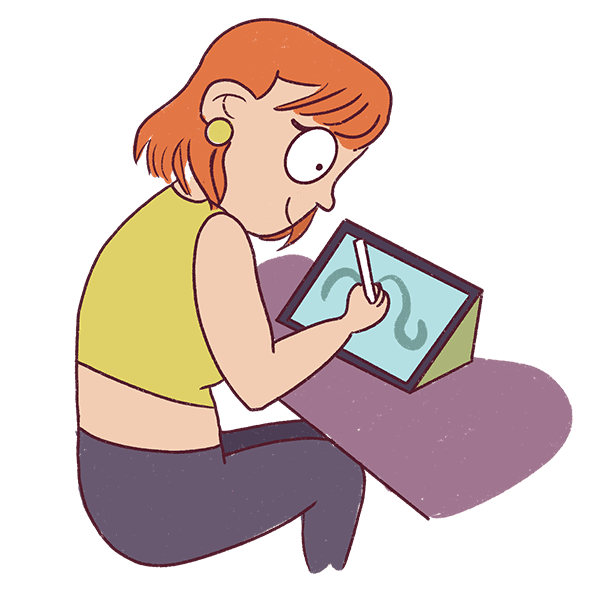
This requires you to be super consistent with your work and draw or create without thinking about perfection.
Do not focus on getting things to look perfect, just focus on sharpening your skills.
Because if you want to become a full-time artist, you need to get used to drawing or creating every day.
When I started working on digital illustrations, I was pretty bad at it.
I knew I sucked at drawing at the time, but I knew that it was something I genuinely enjoyed doing. I was making websites for a living and it was crappy and boring.
But drawing gave me wings.
It made me feel light and I’d itch to finish my work daily so I could practice drawing.
If you are in the same boat, you know the feeling.
So, don’t hesitate to get things right.
If you’re wondering how long it takes to learn to draw, you can read this post.
Remember, at this stage; you can even experiment with different mediums.
I remember how amateurish my illustrating process was. I had no art style and I’d draw random doodles with a black pen before coloring them in Photoshop.
It looked very childish.
I didn’t even own a graphic tablet.
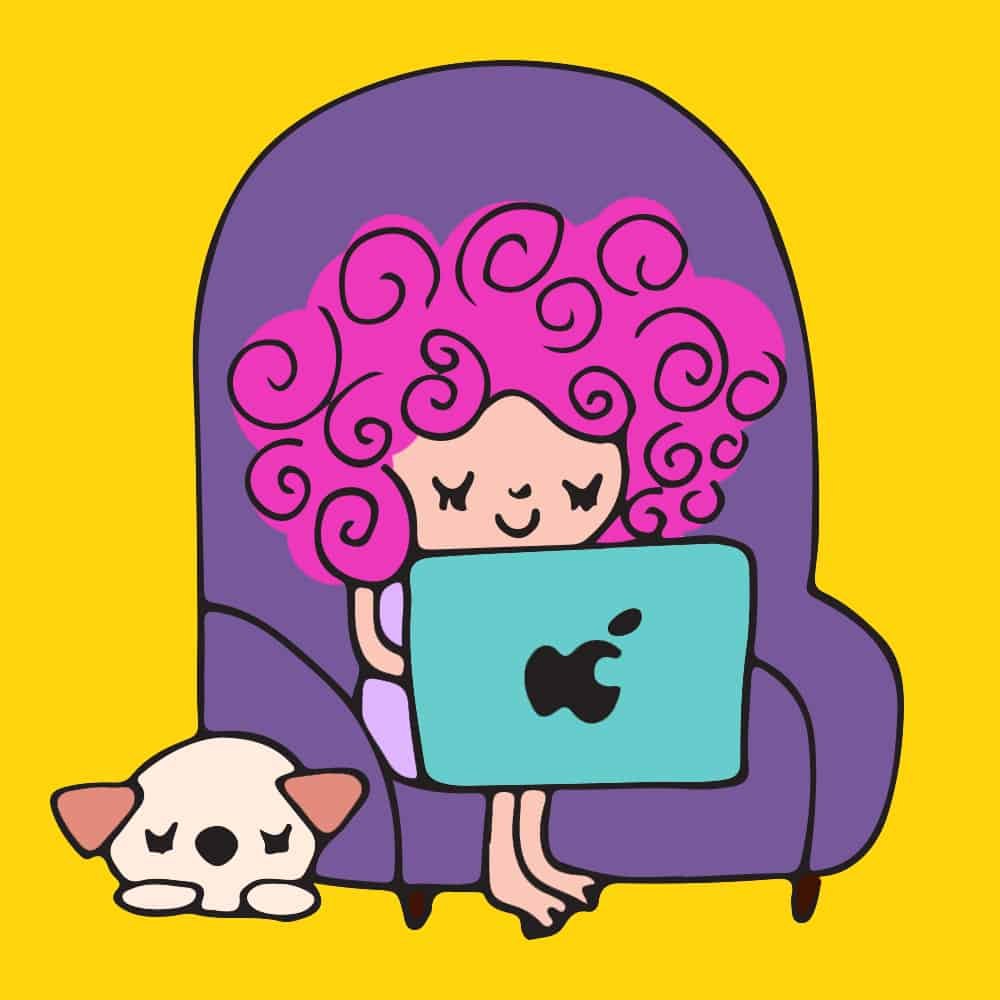
So, don’t focus on making things perfect at this stage.
Because the only way to get better at drawing is to consistently create and get through multiple pieces of art.
You have to create art for the love of art.
3. Learn from others in your desired field
We live in the digital age.
We have access to the internet and we can learn anything we want. There’s information at the end of our fingertips.
So, we can’t give excuses and say, “I don’t know what to do.”
We have to take the time to learn from others who have already accomplished what we want to do.
So, in this stage, figure out who is already doing what you want to do and follow these people.

Most artists have an Instagram page or a Website.
Either way, study from them:
- Look at what kind of art they create on a daily basis
- Read their FAQs. How did they get to be where they are now?
- How exactly are they earning money? Write down those income streams and see if this is something you would enjoy doing.
This is by far the most crucial stage in learning how to become a full-time artist.
You need to figure out what you want to do and learning from other artists who are already at your end goal is the best way to do it!
Because they will help you trace your steps back.
For instance, I started looking at other webcomic artists, and I enjoyed the possibility of working at home myself.
I noticed that other webcomic artists were making money in the following ways:
- Taking commissions for portraits and working for companies and clients
- Creating a Patreon account and working on tutorials/secret comics on that account
- Creating merchandise and selling them on a website or via RedBubble
- Selling tutorials or courses on Teachable or their own Website
And so many others.
Believe it or not, I made money via all these streams before I decided to buckle down and create my own blog.
In this stage, you will learn from other artists and practice heavily in your required field.
For instance, after watching other artists, I realized that I had to strengthen my knowledge in the required areas:
- Studying human anatomy
- Understanding and developing my knowledge in Color Theory
- Discover my own Art Style
So, I started investing in my learning.
I started buying courses and drawing books to help me learn faster.
I watched multiple classes on illustration so that I could understand how to draw human bodies, and expressions and capture movement with cartoon drawing.
Here are some classes I loved:
- Portrait in pencils
- Illustration and Character Design for Children’s stories
- Anatomy of a Superhero
- Drawing in Kawaii Style and Creating Stickers to sell on Etsy
- Developing your Illustration Style and then creating merchandise
You might think that drawing is easy, but it takes a lot of skills to make illustrations look seamless.
Capturing movement and drawing poses took me some time to learn.
And sure enough, my drawing skills started becoming better!
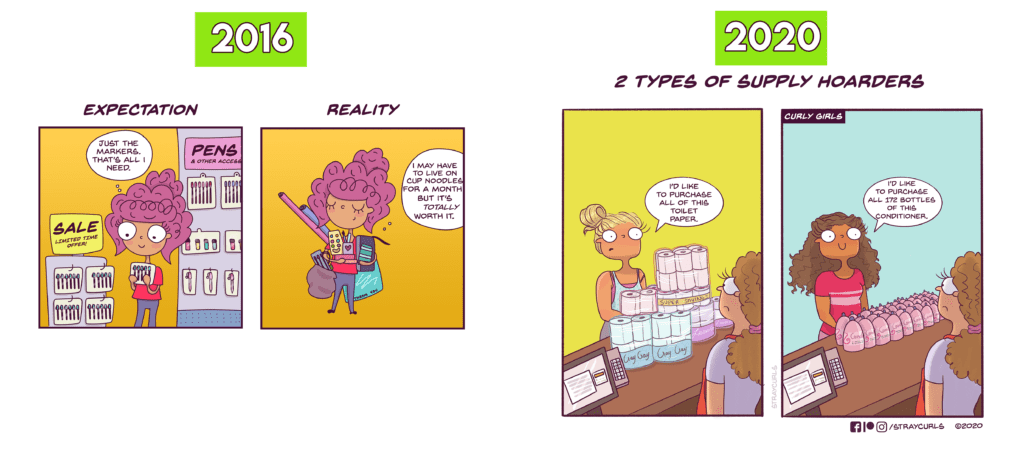
At this stage, I would suggest learning from all the sources you can find.
- Read multiple books in your field to get a better understanding of how you can create art seamlessly
- Take multiple online courses in the arts specific to your field
- Draw and create art consistently
You can also decide if you want to supplement your learning with a proper Art Course or Degree.
Please note that you do not need an Arts Degree unless you are applying to a studio like Disney or Pixar but having an Arts degree may help you pick up drawing faster.
4. Build your portfolio
So far, here’s what you’ve learned:
- You know what to do in the future
- You are practicing daily and drawing and creating art consistently
- You’re following artists in your field and are learning from them
- You’ve gathered resources to learn from, and you are strengthening your art background
Now, it’s time to build your Art Portfolio.
In order to become a full-time artist, you need to show your future clients that you have experience creating work that will suit them.
So, before you even build your portfolio, understand what these companies or clients are looking for.
You need to know who your target audience is.
For instance, if you want to become a children’s book illustrator, then you need to fill your portfolio with pieces that showcase children’s book illustrations.
You cannot create violent art or paint abstract art.
Because you aren’t going to get any clients.
You have to target people who are looking for Children’s Book Illustrators.
Do you get my drift?
This is precisely what I did.
I drew webcomics that targeted only hair. Every comic was about curly hair.
As a result, I got offers to work for Companies that specifically made curly hair products. I worked with Dove, Curl Up, Wella, DevaCurl, Himalaya, and so on.
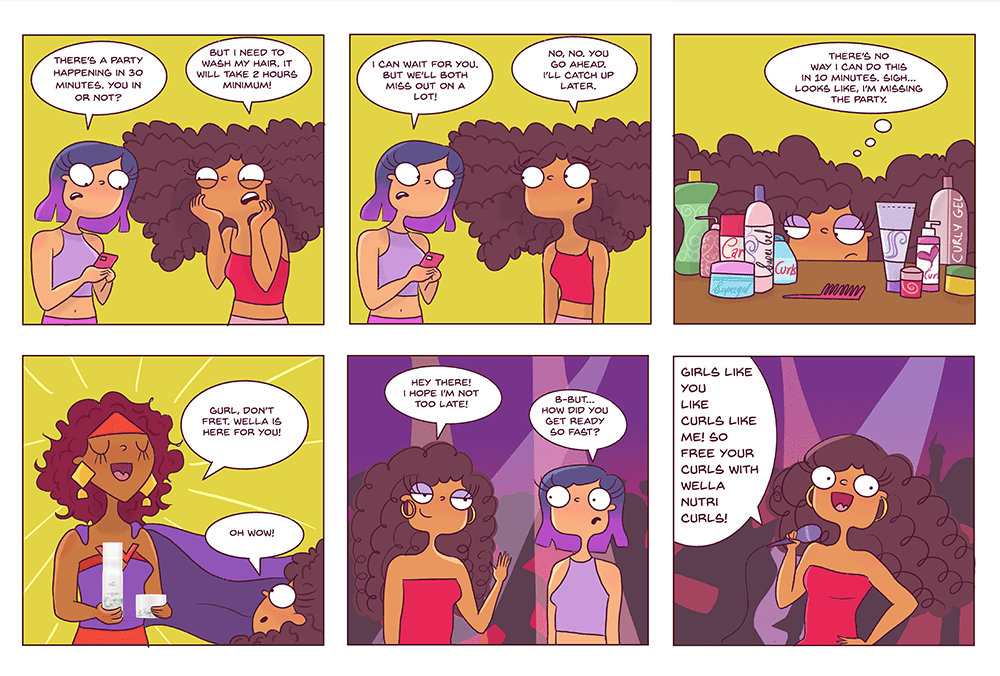
It was fun!
I’ve seen many Artists have a wide-range portfolio that tries to do everything, and because they aren’t specific, they don’t get requests at all.
So, understand who is your target audience first. Ask yourself questions like:
- Are they mostly men or women?
- What is their age?
- What are they specifically looking for in their field?
- How can I stand out from my competitors? What can I post or put up to help them remember who I am?
- Can I work on demo projects to show off my capabilities?
Let’s say you want to be an Animator. And you want to work on projects for Advertising companies. So, you have to build a portfolio full of mini animations that show off your work and capabilities.
It doesn’t matter if you have clients or not, just work on projects that you can show off. It can be your own personal project!
The idea is to build a portfolio that attracts someone in those companies. They should look at your work and go, “This is amazing! Why not hire him/her to work on this campaign?”
This is how you score work!
When you start working on one-off campaigns and get clients and companies, there is a chance that they will hire you for future campaigns.
They may even post your work on their platform, and that may be viewed by other companies who will come to you to hire you for their projects!
Remember to check out other artists in your field.
If you see them building a portfolio on Behance, then do that too.
Watch and observe.
The key to becoming a full-time artist is to learn from the best in your field.
5. Learn to deal with negative feedback
Apart from building your portfolio, you have to develop a thick skin.
You are putting yourself out there. It’s a given.
People from all over the world will have something to say about your art.
Some might say you are not good enough.
Some might give you criticism.
Take the good and leave the bad.
You cannot get anywhere if you don’t know how to take criticism.
This will also teach you to deal with negative feedback when working with clients.
You cannot take anyone’s comments personally. Remember, your art is your business. You want to make money with your art, so you must understand that people are talking about your work specifically.
If someone makes personal comments about you or your methods, ignore them.
Their negative feedback says a lot more about them than you.
Keep this in mind when you are replying to negative comments.
You cannot be snarky, sarcastic, or spew out hatred because this is your portfolio. You have to carry yourself with dignity, kindness, and love.
If someone is being mean, simply block them or ignore the comments.
Do not feed the trolls.
6. Discover your art style and continue to work on your art skills
Now that you’re building your portfolio, you can use this time to sharpen your art skills.
You are never done learning.
Remember this.
As an Artist, you have to keep practicing and improving your work.
So, as you build your portfolio, simultaneously work on refining your art skills.
Continue to take online courses for your art and learn new things.
The more you practice drawing and creating art, the faster you develop your art style.
It is vital to have an art style because this will help people recognize your work. It will also help you build a brand and increase your followers.
7. Be organized with your finances
I’m sorry, but I really feel our education in school is flawed because they do not teach you how to be organized with your finances.
However, if you want to be an artist, you need to know how to save and spend wisely.
It is crucial to be smart with your money.
Also, please note that to become a full-time artist, you have to do it on the side first.
This means you will have to work full-time as something else so that you can pay the bills and support your family while pursuing art as a hobby on the side and taking on any work you can to build experience.
Once your art starts making you enough money, you can start making money as an artist full-time.
The transition takes time.
For some people, it takes years.
They may already have a family to support or don’t have that much time to dedicate to their art.
I made websites for a whole year before slowly transitioning to graphic design.
This was more aligned with drawing but it still didn’t give me that joy because I didn’t have creative freedom.
Once I moved into illustration, I rediscovered my joy of drawing, and I was able to move into it full-time because I had saved a bit of money during my website building to pay the bills.
Another technique you can do is to understand what is your monthly budget.
Once you know how much money you need for utilities and food, you can start saving up for a whole year. If you have enough saved for a year, then you can pursue art and try to make money on the side to support yourself.
8. Treat art as your business
Many people want to make money with their art, but they treat it as a hobby.
They draw only 2-3 times a week when they have the time.
Please note that if you do not take art seriously, why should anyone else do that for you?
Unless you start seeing your art as your business, you will have a hard time getting paid for your work.
It is essential to understand that to become a full-time artist; you need to:
- Be dedicated to learning and practicing art in your field
- Market your Art – you have to shamelessly promote your work to get clients
- Learn how to deal with feedback
- Understand how to price your work and work with clients
This will help you make money with your art and pave the way to becoming a full-time artist.
All of these steps will help make that transition more smooth.
Here are a few tips for building your art business:
- Have a website (it looks more professional and gives you more credibility)
- Create consistently (you can’t create 30 pieces in 1 month and disappear the next – it doesn’t look good)
- Learn to price your work (look at your competitors and see how much they are charging. It’s okay to charge less when you’re just starting so that you can build an excellent file of clients)
Remember to charge for your work.
You need to see the value in your work if you expect others to see the value in it too.
So, always charge for your artwork. Do not do anything for free.
A lot of people will ask you to work for free, claiming:
- It’s for a good cause
- It will help bring you exposure
- They don’t have the funds to pay you right now
Do not fall for these schemes.
Charge for your work.
In the beginning, it’s okay to charge less for your work because you are trying to build a portfolio and get a nice file of clients. But as you keep working, increase your prices.
Read some books and websites to learn how to charge for your artwork.
Here are some excellent books I recommend reading if you want to build an art business:
- Art, Inc.: The Essential Guide for Building Your Career as an Artist
- Art Money & Success: A complete and easy-to-follow system for the artist who wasn’t born with a business mind. Learn how to find buyers, get paid… nicely, deal with copycats and sell more art.
- The Artist’s Guide: How to Make a Living Doing What You Love
- Graphic Artists Guild Handbook, 16th Edition: Pricing & Ethical Guidelines
9. Do not rely completely on one income stream
Yes, being an Artist is not like having a regular job.
You don’t have a big lump sum of money waiting for you at the end of the month.
So, you need to diversify.
For instance, let’s say that you have a Patreon account and a YouTube Channel.
You can lose the Patreon account if Patreon decides to shut down tomorrow. But since you are making money with your YouTube channel, you will still have some money coming in each month.
This is why it is essential to diversify and try to build different income streams actively.
You can also have active and passive income streams.

Your far-off goal should be to increase your passive income ratio so that you have more money coming in for less work.
For instance, working for clients is an active income stream – because you are working on singular projects and only get paid when the project is over.
However writing and illustrating a children’s book is a passive income stream, because once the book is published, you will be paid in royalties for as long as the book keeps selling.
Passive income is undoubtedly better than active income. So, try to focus on passive income once you start getting clients.
This will ensure that you have a paycheck coming into your account every single month.
Frequently Asked Questions
I know this article was pretty huge, but I’m going to try and answer as many questions I frequently get asked to help you some more.
Is it possible to become a full-time artist?
Yes.
We live in the digital age where we don’t even have to sell physical copies of our artwork anymore. Everything is digital.
This means that you can create your artwork online and sell it to anyone across the world.
The key to becoming a full-time artist is to figure out what you want to be in the first place.
For instance:
- If you love drawing plants and flowers, you can specifically create botanical illustrations for books or sell clipart of flowers and plants on Etsy or Creative Market
- Or if you love drawing child-like illustrations, you can become a children’s book illustrator or take commissions for your work.
- If you love creating your own characters from scratch and love 3d modeling those characters, you can consider a future in a video game company where you create and conceptualize original characters.
The possibilities of becoming a full-time artist are endless!
Is it possible to make a living as an artist?
Yes, it is possible to make a living as an artist!
Most artists work on the side or develop their art skills on the side while practicing a full-time job. Once they start earning money with their art, they slowly transition to making a living as an artist full-time!
The key is to be really organized with your finances and create goals for your art and future.
Once you realize where you want to be and what you want to do in the future with your art, you can slowly work towards your goals while working your full-time job.
There are countless people studying art and taking on commissions on the side while working part-time or full-time at other jobs.
In the beginning, I’d aim to earn $50-$100 per month drawing.
I kept increasing that target month by month till I could replace my work as a Website Designer with my Illustrating career.
How do I start my career as an Artist?
- Know your end goal
Figure out what kind of artist you want to be and trace back the steps. Follow people in your field and see what they are doing. The key is to learn from others who have already done what you want to do. - Practice creating art every day
Now, you already know your end goal. So, start working on art every single day. Build your portfolio and improve your art so that you can develop your art style. The key is to create art consistently so that you can build a brand. - Know your target audience
When posting art on your social media, remember your target audience. If you want to work as an Animator, your work can’t be still images. You’ll have to create mini animations to show your future clients what you are capable of. - Start taking up paid work
Work for clients and companies to improve your art skills and get better at your art. You need to have experience working with people. Remember to charge for your work. - Develop your business skills
Organize your finances. Learn how to price your work. Learn how to market your artwork and shamelessly promote your work on all platforms. This is the best way to build a brand.
Why do most artists fail?
I’ll be honest.
Most artists fail because they just don’t have the right mindset.
They either don’t have faith in themselves and continuously make excuses about not creating, or they just don’t put in the work.
They draw for 1 month and then give up when they don’t see any money coming in.
Or they’ll post 9 posts on Instagram and wonder why people are not lining up to buy their work.
Please understand that years go into developing an art style.
Once you develop an art style that people recognize and love, they will start hiring you. Your work should also align with the future you see.
For instance, if you want to develop characters for video games, but your Instagram is filled with art of flowers, vehicles, and sceneries, how do you expect to be taken seriously?
It is crucial that you understand who you are aiming for before creating and publishing work.
Most artists fail because they either don’t know what their end goal is or they aren’t committed to putting in the work till they see success.
How do beginner artists make money?
Validate how good you are by putting your work on social media first.
This is the best way to grow an audience that specifically likes your type of art.
Once you find your art style and are consistently publishing work in that specific art style, advertise that you take up commissions on your posts and stories.
The key is to promote yourself everywhere.
Once you start getting clients, figure out what kind of work you like doing and slowly increase your prices.
You can make money as a beginner artist in several ways:
- Take up commissioned work from clients and companies for your work
- Start a Patreon work
- Sell stickers, notebooks, and bookmarks (your merchandise) on Etsy/Creative Market or your own website.
- Start an art blog and earn money via ads.
- Create and sell a course – like an in-depth tutorial
- Sell your own book
The possibilities are endless when it comes to making money as an artist.
Conclusion + Resources to become a full-time artist:
If you’ve reached the end of the post, then congratulations – you really want to draw and become a full-time artist.
I honestly feel you should pursue art and make money as an artist.
I hope this post has given you a decent understanding of what it takes to become a full-time artist.
Remember, you do not need a degree.
As long as you are dedicated to improving your art skills and practicing daily, you can make it as an Artist in this world.
Study from your competitors and get courses and books to help you learn faster!
That’s precisely what I did.
I will share a couple of resources that helped me become a full-time artist.
Books that helped me learn more about drawing:
- How to Draw Anime ( Includes How to Draw Manga, Chibi, Body, Cartoon Faces )
- Making Comics: Storytelling Secrets of Comics, Manga, and Graphic Novels
- Sketch Every Day: 100+ simple drawing exercises from Simone Grünewald
- Figure Drawing: Design and Invention
Books that taught me how to make money with my art:
- Draw What You Love: The Art of Simone Grünewald
- Becoming a Successful Illustrator
- Graphic Artists Guild Handbook, 16th Edition: Pricing & Ethical Guidelines
- Art, Inc.: The Essential Guide for Building Your Career as an Artist
Courses that helped me create better art digitally and gave me wonderful business ideas:
- Procreate for Beginners: Digital Illustration 101
- Drawing for beginners
- Female Cartoon Character Design with Procreate
- Creating comics for Instagram
I credit my illustrating skills only to books and online courses entirely because I didn’t really have anyone to teach me, and my learning is completely self-taught.
I do not have any degree in art whatsoever.
Everything I’ve learned, I’ve learned from books and courses.
I know there is a lot to improve and I do practice daily, even if it’s a small doodle or sketch.
Additionally, I love online courses because you can draw and create while the teacher does the same in their courses.
And you get to compare your work to the teacher’s so you can correct yourself if you’re making mistakes.
If you enjoyed this post, you’d also like:
- The ultimate guide to finding your art style
- Is digital art easy? Read the pros and cons of traditional vs. digital art
- Why do people love drawing? Drawing Benefits you should know!
- How long does it take to learn how to draw? From newbie to pro!
- 13 drawing mistakes that most beginner artists make
- 13 signs you are meant to be an artist
- 10 fun drawing gifts to give children below the age of 10
- 13 easy ways to make money online as an artist
- 9 best drawing books for beginners
- How to draw without a reference
Do you have any questions? Please leave a comment below and I’ll be more than happy to help you!



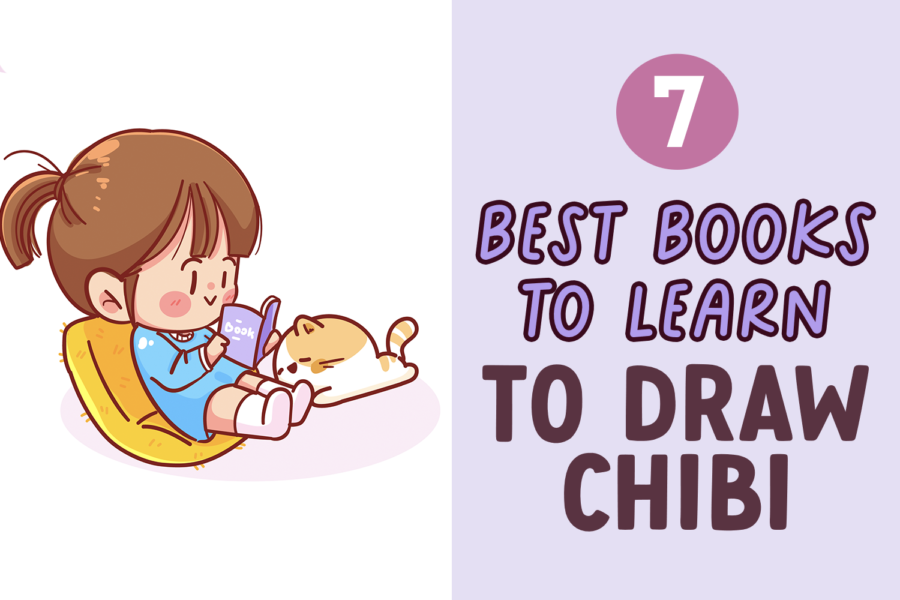


Leave a Comment